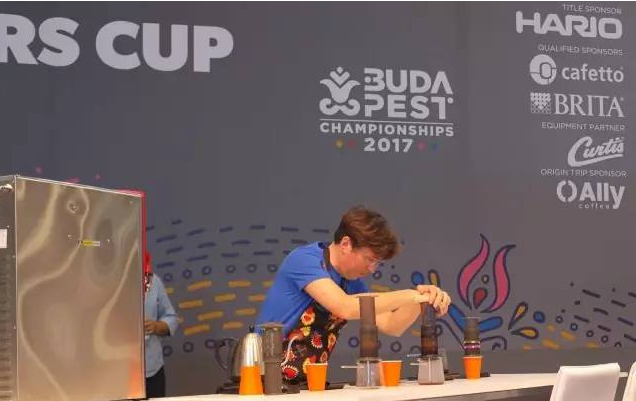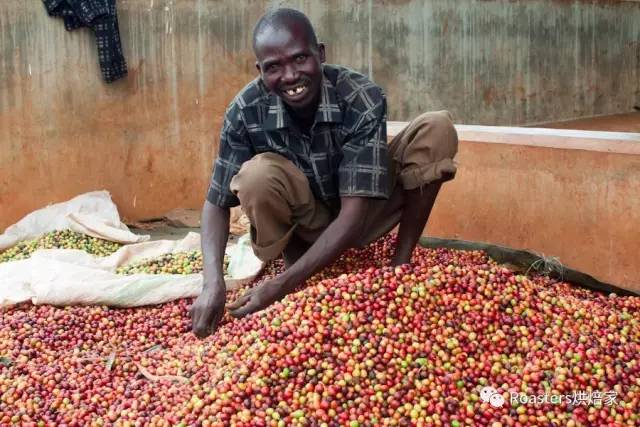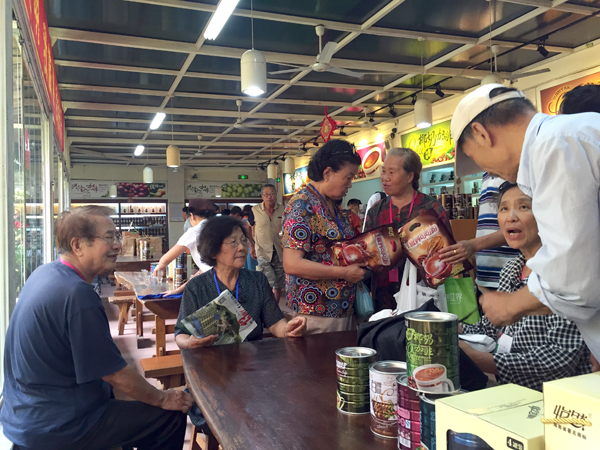Austrian brewing champion Michael Manhart Austrian brewing champion and his Ugandan coffee
Michael Manhart, a barista from Austria, finished fourth in the 2017 World Coffee Brewing Competition, and his Ugandan coffee and the highest designated brewing score were impressive enough. Surprisingly, Michael is not a full-time barista. This coffee lover, who works as a primary school teacher trainer, has participated in three Philharmonic pressure competitions, three cup test competitions and two Austrian coffee brewing competitions (runner-up in 2016 and champion in 2017) since he came into contact with coffee in 2013.
At the just-passed international competition, Michael unveiled an unknown variety of Ugandan coffee in front of the world with a ceramic filter cup developed by himself and a contrasting cute strawberry apron. The simple brewing technique and desktop display, the Michael that rambles on to tell you the story of this coffee, feels as comfortable as a friend entertaining you for coffee at home. This time, I had the honor to interview Michael to listen to the coffee philosophy of this "old driver" in the family coffee circle.
First, let's take a look at his cooking parameters for two games:
Specify Compulsory Service
Coffee beans: central America, washed
Utensils: Elle presses
Modus operandi: Inverted
Degree of grinding: percolator of Bunn bean grinder
Cooking strategy: 30g powder, first inject 120g 85 °C water, stir for 10 seconds, stand for 40 seconds and then extract. Then, 90 grams of 85 °C water is added to the extracted liquid and stirred to produce coffee.
(Michael is making a designated brew of coffee. The picture is from the contestant.)
Open Service:
Coffee beans: Ugandan coffee, sun-treated (growing on manors at 2380 meters above sea level, Mzungu Project batches, unknown varieties)
Water: add Third Wave water
(Third Wave water blending powder, picture from the Internet)
Ratio: 16g coffee powder, 250g water
Grinding: coarse, sieving powder below 600 microns
Time: no more than 2 minutes (1: 48 "used in the game)
The water temperature is 94 °C and the internal temperature of the filter cup is 92 degrees.
Flavor description: aroma: spices, sweet, syrup, black cherry
Flavor: slight bitterness of black cherry, strawberry and cranberry
Huigan: chocolate, fruity
Cooking strategy: 1-2-3 strategy, 250g moisture is 40g, 80g and 130g, and the filter cup with larger filter hole is selected to save cooking time.
Exclusive interview question
Q: could you introduce yourself briefly? How did you get into the coffee industry?
A: I'm Michael Manhart. I'm 44 years old. I have a wide range of interests (music, cooking, my work, coffee and my favorite family). Before I entered the boutique coffee industry, I was not really interested in drip coffee because it didn't taste that good. So I started drinking espresso and planned to buy a set of household appliances. One day six years ago, I went to Kaffee Alchemie, a coffee shop in Salzburg, to buy utensils, where I tasted a cup of Finca Kilemanjaro (El Salvador) hand-brewed coffee, and then it all happened. Instead of choosing Italian coffee utensils, I started my own brewing instead.
Q: do you have any feelings about this competition?
A: it was a great experience! I met a lot of interesting people and discussed all kinds of coffee together, which made me have a lot of new ideas. When you are surrounded by a group of people who love coffee, it is really difficult to accurately use a specific word to express your joy. There are a series of rules for the whole game, so you have to follow the rules. But it was a great experience.
(practicing the Michael of the competition, the picture is from the contestant)
Q: are there any challenges in preparing for this competition?
A: the game is a "protracted game", which means you have to prepare for a three-day game for months. There are too many things to do on the way to prepare for the race. After determining the beans for the competition, I began to adjust my presentation process to make it more refined and perfect. But I encountered some problems because I wanted to shorten my extraction time without changing the grinding degree, so as to make my coffee taste "more fruity". Then I started looking for suitable cooking utensils, so I tried the metal Kalita filter cup. Then the next challenge is the temperature change inside the filter cup. If you use a metal filter cup, there is no way to control the temperature. So, together with my good friend, I began to use clay / ceramic to make my own filter cup. The final filter cup was made two weeks before the game to make the coffee more perfect.
Q: how do you feel about this cooperation with Rubens Gardelli? Why did you choose this bean?
A: it's a real honor to fight with him. He loves coffee very much, and he knows a lot about it. I like the way he bakes, and it's similar to mine. In the 2017 Austrian cooking contest, I won with a Rwandan bean. In this international competition, I finished fourth with a Ugandan bean. I am very grateful to Rubens Gardelli for letting me test this coffee blindly. A large part of the score for optional cooking depends on the quality of the beans, so it is important to choose a good bean. I checked the records and records of previous competitions, and Rose Xia always stands out, very subtle, but I hope to break the rules and bring some surprises and something different in this competition, and this bean is what I want.
(Rubens Gardelli and Michael Manhart hold his homemade filter cup, picture from the contestant)
Q: what do you think of the current "Rose Summer match" phenomenon?
A: as I said before, there are many players who use rose summer in the brewing competition, but I believe we don't have to use rose summer. For example, I used Ugandan coffee this time and got a high score. There are many great coffees in the world, and Rosa is one of them. If people treated other coffee like Rosa, we wouldn't talk about it here. So I think, if you want to win this competition, you need to have a good bean, and then use the cooking skills to maximize it, whether you use Rosa or not, that's not a question.
Q: some readers want to know where I can buy the filter cup you use in the game?
A: this filter cup is a limited edition. We have only made 15 of them now. I have no intention of selling them, but if there is a real demand, I will consider making more. I would like to thank my friend Bernhard Sr. Put a lot of energy into this with me. (for more information, please visit www.facebook.com/kaffeebruder.)
Q: I heard that you also play music?
A: yes, I joined the local band (as a guitarist). I often bring some coffee to everyone during the band rehearsal.
Q: as an "old driver" of family coffee, do you have any suggestions for beginners when buying household brewing utensils?

A: no problem. If you're going to make coffee at home, here are some suggestions that can help you make it easier and more stable: first of all, you need a good bean grinder (hand grinder, but only if you choose a good one). You need an accurate electronic scale (preferably to 0.1g), and then choose a filter that suits you (filter cup, Elle pressure can all try). Then find a coffee bean you like and try it!
Q: what is the premium coffee market like in Austria?
A: the coffee market here is developing. I think customers are ready to accept high-quality coffee. Of course, there are still some ancient traditions in the area. It's like the difference between milk chocolate and pure dark chocolate, it's not about which is more popular, but that you like the cup in your hand.
Q: are there any plans for the future?
A: not yet. Let nature take its course.
Important Notice :
前街咖啡 FrontStreet Coffee has moved to new addredd:
FrontStreet Coffee Address: 315,Donghua East Road,GuangZhou
Tel:020 38364473
- Prev

Uganda TOH champion Kawahibi / Cabewa
Uganda TOH champion Kawahibi / Kabewa Uganda Kawa Cooperative / Kabewa; Picture / from the Internet every year major coffee producing countries in Africa hold a national raw bean competition called the "Harvest season Flavor Competition" (The Taste of Harvest; TOH), similar to the Cup of Excellence Cup in Central and South America. TOH has become the discovery of Kenya and Yesso.
- Next

Watch out! Apart from tourists, what else can save the once brilliant authentic Xinglong coffee?
Presumably, there is such an experience when traveling to Xinglong, Hainan: Xinglong overseas Chinese Farm Coffee Factory is located in a botanical garden. We took us here with a tour guide to visit all kinds of tropical plants. The coffee factory exhibition area is very small. Some faded display boards introduce common knowledge such as coffee cultivation and coffee etiquette, which are easy to understand. There are some different kinds of coffee planted on both sides of the road, but it's a pity
Related
- Detailed explanation of Jadeite planting Land in Panamanian Jadeite Manor introduction to the grading system of Jadeite competitive bidding, Red bid, Green bid and Rose Summer
- Story of Coffee planting in Brenka region of Costa Rica Stonehenge Manor anaerobic heavy honey treatment of flavor mouth
- What's on the barrel of Blue Mountain Coffee beans?
- Can American coffee also pull flowers? How to use hot American style to pull out a good-looking pattern?
- Can you make a cold extract with coffee beans? What is the right proportion for cold-extracted coffee formula?
- Indonesian PWN Gold Mandrine Coffee Origin Features Flavor How to Chong? Mandolin coffee is American.
- A brief introduction to the flavor characteristics of Brazilian yellow bourbon coffee beans
- What is the effect of different water quality on the flavor of cold-extracted coffee? What kind of water is best for brewing coffee?
- Why do you think of Rose Summer whenever you mention Panamanian coffee?
- Introduction to the characteristics of authentic blue mountain coffee bean producing areas? What is the CIB Coffee Authority in Jamaica?

